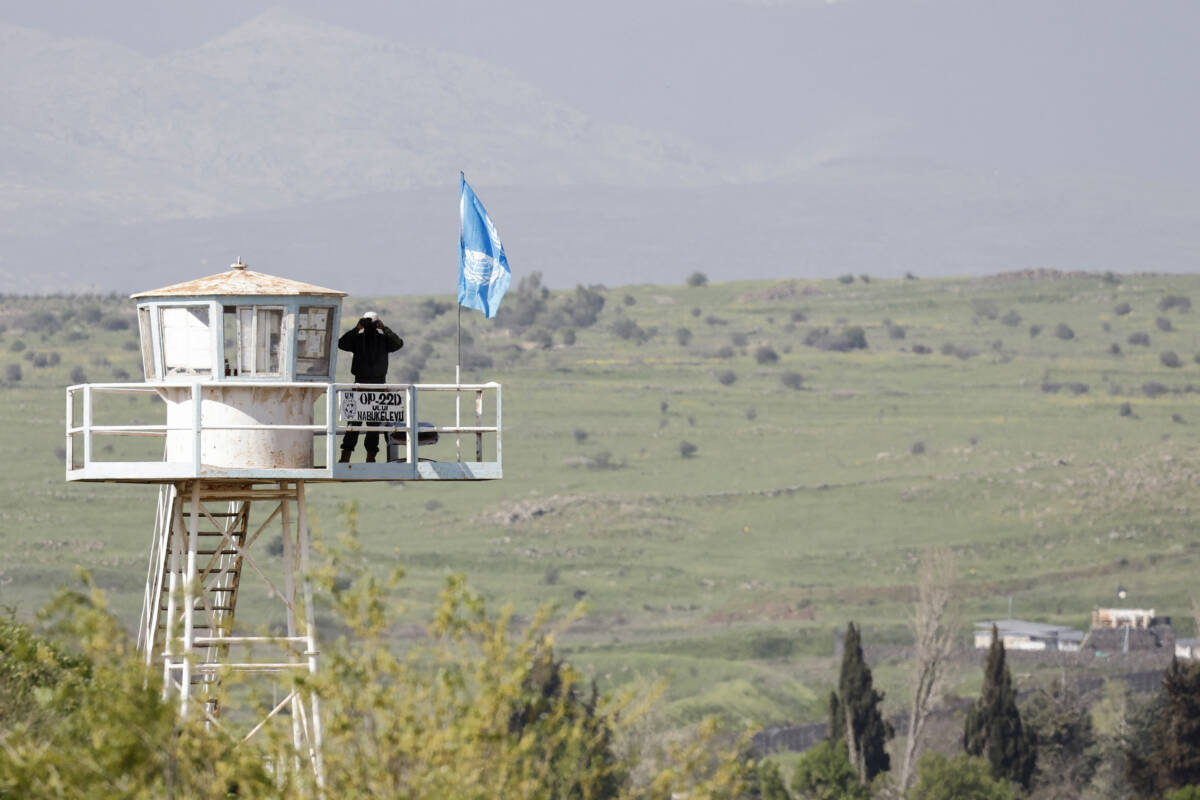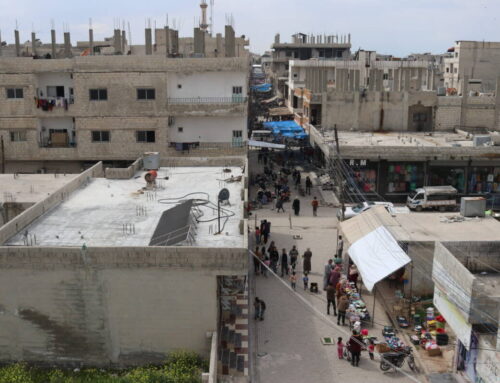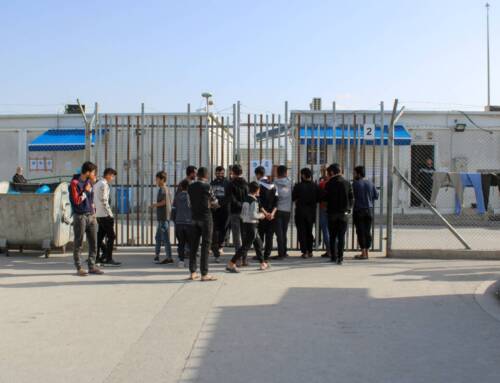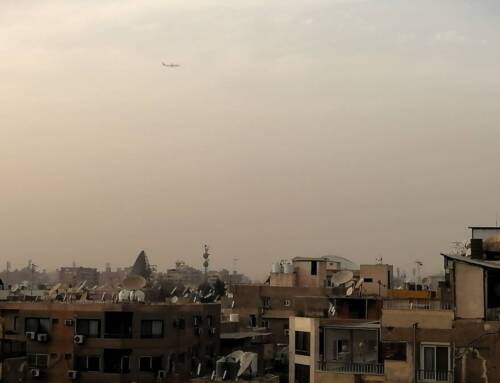Why Syria matters as Israel and Iran’s shadow war moves into the open
While the immediate threat of open war between Iran and Israel has receded in the wake of this month’s unprecedented escalation, the risk of renewed conflict lingers. Syria—fertile ground for another spark—remains a place to watch.
24 April 2024
MARSEILLE — Syria has long been a key battleground in Iran and Israel’s shadow war. But since October 7—when Iran-backed Hamas launched its ground incursion into Israel from Gaza—attacks on and from Syrian territory have proliferated in scale and scope.
It was in Syria that an Israeli strike sparked this month’s unprecedented escalation between Iran and Israel. In the wake of Tel Aviv’s April 1 assassination of top Iranian commanders at Tehran’s consulate in Damascus, the two countries reached their highest level of direct conflict to date. When Iran and its regional proxies fired a barrage of missiles and drones at Israel in response on April 18, a longstanding red line was broken.
The following days brought signs that both Tehran and Tel Aviv sought to avoid a region-wide escalation. Israel, under United States pressure to temper its response, launched limited strikes against Iran and Syria on April 21. Iran has since downplayed the significance of the retaliation. Still, the risk of renewed conflict persists. In any future escalation, Syria is not likely to be far from the scene.
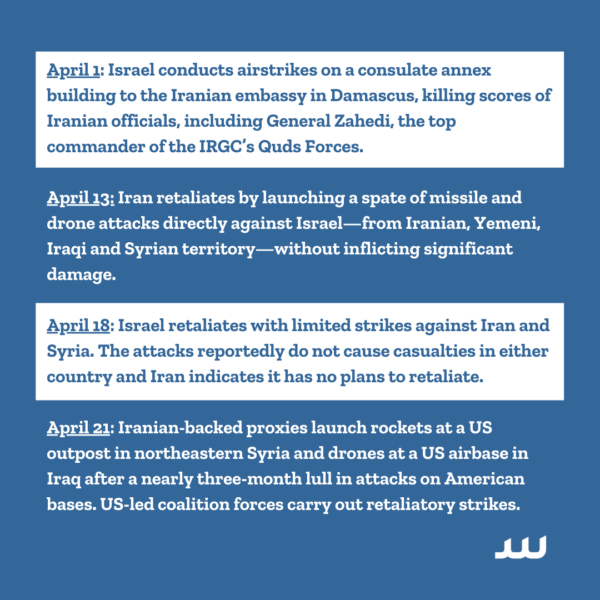
Syria’s role
Syria has long been an “open field” for Israel, Hanin Ghaddar, a senior fellow at the Washington Institute, told Syria Direct. “They feel they can do whatever they want.” Without significant Iranian deterrence, Israel has struck Iranian personnel and Tehran-backed militias and infrastructure in Syria for years.
In Lebanon, unlike in Syria, there are still “unspoken red lines between [Iran-backed] Hezbollah and Israel,” she added. “In Lebanon, they will continue this current status quo with some escalation depending on what Hezbollah does.”
Conflict between Tel Aviv and Hezbollah across Lebanon’s southern border ramped up over the past six months, but has mostly been contained to cross-border shelling. Israel, meanwhile, has carried out targeted assassinations of Hezbollah and Hamas commanders through airstrikes in Lebanon.
Still, Ghaddar expects Syria will remain the primary arena for Israel and Iran’s struggle. “Syria is different, Syria has always been different,” she said.
Hezbollah is Iran’s “defensive shield,” an “insurance policy” that Tehran is only prepared to use if directly threatened, Ghaddar said. In Iran’s response to the bombing of its consulate—the most direct confrontation to date between Tehran and Tel Aviv—Iranian missiles and drones were launched from Syria and other countries, but not Lebanon. Ghaddar called this a “strategic choice” because Iran wants to “keep Lebanon safe from an all-out war.”
Charles Lister, a senior fellow at the Middle East Institute, agrees that Syria is a place to watch, but argues that it—not Lebanon—is the main regional asset Iran aims to protect.
“Iran feels there’s a lot at risk in Syria,” Lister said. While Tel Aviv has launched over 50 deadly, high-precision airstrikes on Syrian soil since October 7, Iranian backed proxies have responded with lower intensity—largely symbolic—shelling against the Israeli-occupied Golan Heights, without causing casualties.
In Syria, Israel has the greatest “freedom to maneuver” and strike Iranian assets, Lister said. For Iran, its “territorial influence and control” in the country is essential, he added. Tehran’s influence is deeply entrenched in Syria, where the Assad regime has effectively become a client state. Unlike in Lebanon, Iran has boots on the ground in Syria, in addition to an array of proxy forces it controls. Syria is also the “linchpin” of Iranian regional supply routes connecting Iran, Iraq and Lebanon, he said.
“If there was any front that the Iranians cannot risk losing, it’s the Syrian front,” Lister concluded.
Increased escalation
Over the past decade, Haid Haid, a fellow with Chatham House, has observed a “clear escalation” between Iran and Israel playing out in Syria.
As Syria’s war developed, and Damascus increasingly leaned on Tehran for support, Iran’s footprint in Syria grew and Israel took note. At first, Israel attempted to reduce the supply of “weapons channeled through Syria to Hezbollah in Lebanon,” Haid explained. Iran responded by “increasing its presence inside Syria and trying to produce weapons” locally.
Iran reportedly uses Syrian military facilities to produce drones and other weapons for its proxies, some of which are exported to Hezbollah in Lebanon while others are transferred to its ally the Assad regime to combat opposition forces in Syria’s northwest.
As Iran’s presence in Syria and across the region grew, Israel shifted to its current approach: directly “targeting Iranian facilities…and eliminating Iran’s commanders,” Haid said. For him, this represents a “major departure from the traditional rules of engagement,” which previously saw Hezbollah and other proxy forces as Israel’s primary targets.
For all three analysts, the most recent escalation by Israel in Syrian territory is unprecedented. As Tehran and Tel Aviv’s conflict simmers, Syria remains a key arena, as what happens between the two rivals there holds serious implications for the region writ large.
“Wars are a lot harder to prevent from spiraling than shadow wars, which typically have many kinds of unspoken red lines,” Lister said. But as those red lines are crossed, the trajectory of the proxy conflict becomes “unpredictable.”
For now, open war between Israel and Iran appears to have been averted. No deaths were reported when Iran and Israel directly struck each other’s territory, and Iran has signaled it does not seek further retaliation.
If Israel and Iran decide to continue to de-escalate tensions, the situation on the ground “will go back to the status quo in Syria, which is not very calm,” Ghaddar projected. However, the specter of a renewed round of escalation persists.
While the Damascus strike was dramatic, Israel can always do more against Iran in Syria, Lister said. One lesson Tel Aviv took from the October 7 attack, he said, was that “mowing the grass”—containing rather than eliminating Iranian activity, along the lines of a similar strategy towards Hamas in Gaza before the current war of annihilation—is insufficient.
This shift explains Israel’s increasing “willingness to inflict higher casualties, kill more IRGC directly, hit larger ammunition depots, and even strike shared facilities with the Syrian regime,” Lister explained. It could also mean a further increase in targeting IRCG safe houses in more urban areas, such as Aleppo or Sayeda Zainab just outside Damascus, where the Quds Force maintains a presence, he added.
Since October 7, civilians have been killed in multiple Israeli strikes in Syria, according to open sources. On March 29, Israeli airstrikes near Aleppo airport killed at least 36 Syrian soldiers, as well as civilians.
It is “difficult to identify a ceiling to such escalation,” Haid said. Israel could cause “way more damage to Syrian facilities and Syrians in general.”
Wider conflagration
Increased casualties among Syrian soldiers and civilians, however, are unlikely to draw the Syrian regime directly into the fray, the analysts agreed. So far, the Assad regime has avoided retaliating directly against Israel for strikes in its territory.
Lister does not believe this will change, unless “Israel does something on Syrian soil that forces it to change.” According to sources close to Iran, Assad has opposed Iranian attacks from Syrian territory, fearing retaliation against him and his regime. Haid speculated the Syrian regime could be playing a role behind the scenes to reduce the number of attacks from Syrian soil, even if it is unable to fully stop them.
Other actors, however, could increase conflict levels in Syria. Since October 7, the Syrian regime and Turkey have opportunistically bombed the opposition-controlled northwest and Kurdish-controlled northeast, respectively. “The regime has benefited from the world’s focus on Gaza to increase its attacks on northwest Syria,” Haid said.
In the northeast, increased attacks on American bases by Iranian-backed forces could “draw the US into having to respond more aggressively,” Lister said. After a nearly three-month lull in attacks, Iranian proxies fired rockets at US military bases in northeast Syria and Iraq on Sunday.
Both he and Haid said Iranian-backed shelling could, in turn, could pull the US-backed Syrian Democratic Forces (SDF) into renewed conflict in Deir ez-Zor—where Iranian-backed forces have been involved in Arab tribal attacks against the group. The past year has seen a “much greater level of IRGC investment” in northeastern and eastern Syria along control lines with the SDF, Lister added.
While the risks of direct confrontation between Iran and Israel appear to have subsided for now, Syria remains a key site of contention—fertile ground for another spark.

